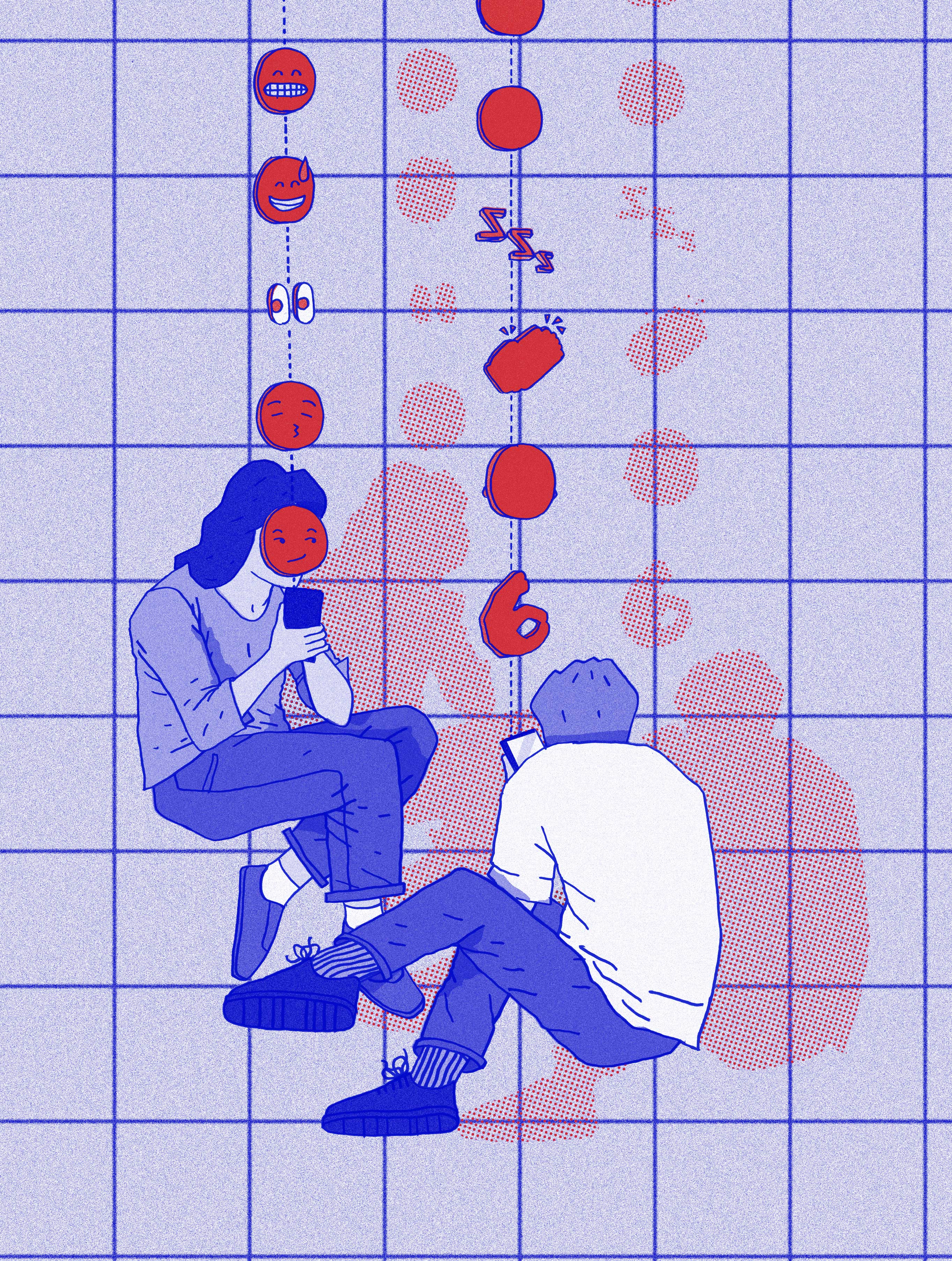
It’s a familiar situation – you’re trying to organise a night out but everyone in your WhatsApp group is coming up with a different place or time to meet. Plus you have a hundred other emails to answer, notifications are popping up and a meeting’s about to start. Instead of a lengthy reply, you send a 👍 to one person’s suggestion of dinner.
This is the age of constant connection – and distraction. Emails, Instagram, Skype and Facebook all make it easy to stay in touch with a wide network of friends, yet the time required to actively maintain these links is often lacking. Enter emoji. Simple, fast and increasingly ubiquitous, emoji offer an immediate point of communication. Take the dinner confirmation, for example: you can make yourself clear without typing a single word. This is a widespread phenomenon. ;Emojitracker, a website that shows real-time emoji use on Twitter, gives an insight into their overwhelming popularity: its tallies of hearts, crying faces and pizza slices reach the millions.
Emoji are becoming embedded into popular culture, from the full translation of Moby Dick into Emoji Dick to Drake’s praying hands tattoo, and they have even extended into broader societal issues. The success of the long-standing campaign for greater racial diversity in the emoji spectrum resulted in a major Apple update in April 2015, signalling a transition from frivolous smileys to a more legitimate mode of communication.
Instagram, which has used emoji since its launch, recently introduced the use of emoji in hashtags. According to the company, 40% of all photo captions posted to the platform now contain at least one emoji, an increase from around 20% in 2012-2013. “It is a rare privilege to observe the rise of a new language,” says Thomas Dimson, a software engineer on Instagram’s data team, in a company blog post. “Emoji are becoming a valid and near-universal method of expression in all languages.” The rise of Instagram itself as a wordless means of expression is indicative of the power of images, and emoji are able to harness this appeal across multiple mediums.
A 2013 report published on Statista.com on sticker and emoji usage in mobile messaging apps found that 74% of Americans have used emoji, and 35% use them daily. In China, the figure for daily use rose to 43%. In Southeast Asia, the popularity of stickers within the LINE instant messaging app is particularly striking: 560 million people worldwide had registered as members at the beginning of 2015, the majority of them in Japan, Taiwan and Thailand. Stickers and smileys could represent a new era of seamless international communication, overturning barriers of language and dialect. While the nuances of real emotion may be lacking in 😿 and 😜, their simplicity is also a major factor in their popularity.
While these broad strokes might lead to occasional misunderstandings, Dr Alice G B ter Meulen, a professor in the department of linguistics at the University of Geneva, notes that this can open up new possibilities in a conversation. She distinguishes emoji from descriptive text due to their performative nature – a linguistic term that denotes that truth or falsity cannot be demonstrated. “Emoji can be interpreted differently by different users and even by two people engaged in a communication,” explains ter Meulen. “You may send an emoticon with sadness and mean that you regret the last thing that you typed, but the receiver may understand that you are sad because of something they wrote. So emoji are ambiguous, but that is so often also useful – purely disambiguated conversations are very boring.” Emoji offer a new means of demonstrating emotion, layering our communication with visual signposts. Emoji are ambiguous, but that is so often also useful – purely disambiguated conversations are very boring It’s evident that emoji are becoming assimilated into the vocabulary of our lives. Could they in turn influence not just how we communicate with one another, but how we think? American linguist Benjamin Lee Whorf developed his theory of linguistic relativity in the 1930s, stating that the structure of a language affects the ways in which its speakers conceptualise the world around them. He proposed that dramatic differences in vocabulary could influence the way the brain processes information, linking language with human behaviour.
“As digital communication among the very young becomes more popular, so does the use of emoji,” says graphic designer Callum Copley, who believes that emoji are having a disruptive effect on language today. “I think it is plausible that deterioration in the quality of communication could take place, and people could become over-reliant on emoji to express themselves. Many complex emotions are not represented with emoji, and quite possibly never could be.”
Copley plotted a wide spectrum of emoji on a graph, before cross-referencing the results with psychologist Robert Plutchik’s 1980 wheel of emotions model, which categorises emotions and how they interact. Copley found the emoji spectrum to be heavily weighted towards basic positive emotions, with little nuance. “A user growing up with emoji integral to their ability to communicate may end up only able to express themselves using these melodramatic symbols,” he suggests. “Furthermore, complicated, abstract feelings may become completely alien and lost forever to some. With so many people choosing to engage in such a reduced form of dialogue, neglecting to search for richer ways to express themselves within their native language, a crisis of communication is highly likely.”
The concise nature of emoji might be seen as reductive, but this is also a key aspect of their widespread appeal. They are highly accessible and easy to digest, as comprehensible for a six-year-old as they are for a 36-year-old. “I think that it’s a fascinating phenomenon,” writes the Guardian’s design critic Oliver Wainwright, over Instant Messenger. “Just as Twitter has honed the discipline of reducing ideas and opinions down to 140 characters, emoji force you to condense your thoughts into a super-limited vocabulary of tiny pixelated cartoon symbols.” Wainwright then adds a few of his own favourite emoji:💃👯👊. Taken up with enthusiasm by teens and adults alike, emoji tap into a sense of fun that is not defined by age. Often used to add an ironic edge to a message, they have proliferated beyond this into experimentation that can lead to results that are functional, challenging, or downright weird. New and surprising combinations of emoji can be used to form rudimentary sentences, expanding the limits of what they can express.
Emoji are undoubtedly entwined with the language of our times. In a hyperconnected digital age, they make it easier for us to stay in touch. They are replacing text-speak and acronyms with a newly condensed mode of representation and communication. Emoji might not be as developed as the written word, but they open up new possibilities of expression by virtue of their inherent simplicity, transcending the barriers of language. Rather than the worldwide rise of emoji signalling a crisis of communication, we might just have found ourselves in an age of renewed connection.
Watch the trailer for our new age film by Lucy Luscombe
Let us know what your attitudes to age are via Twitter, Facebook and LinkedIn
Illustration by Tom Deason


